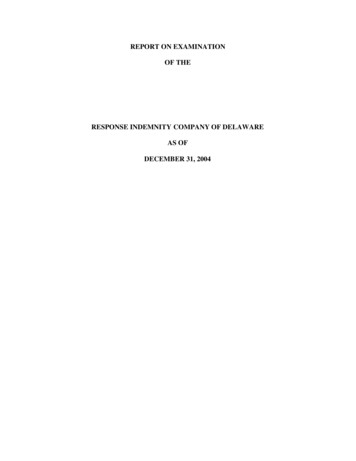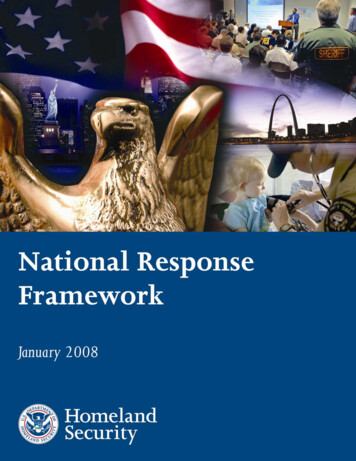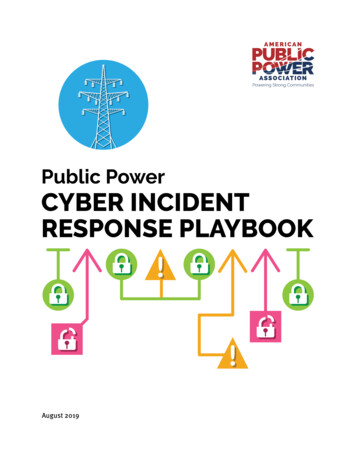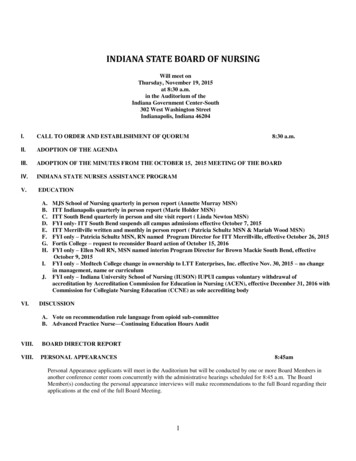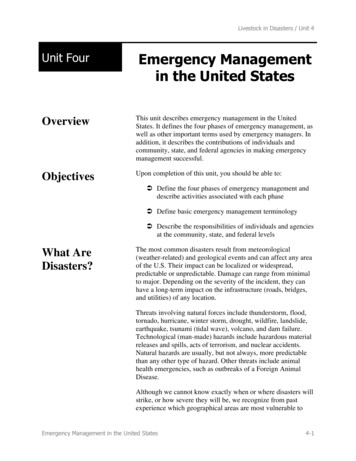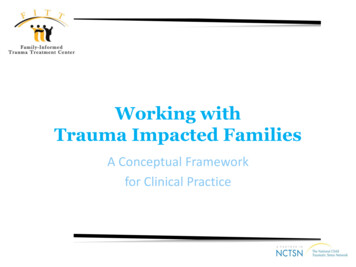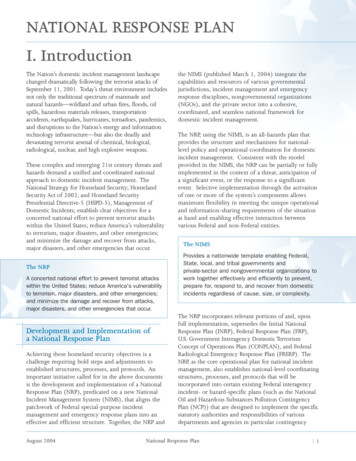
Transcription
NATIONAL RESPONSE PLANI. IntroductionThe Nation’s domestic incident management landscapechanged dramatically following the terrorist attacks ofSeptember 11, 2001. Today’s threat environment includesnot only the traditional spectrum of manmade andnatural hazards—wildland and urban fires, floods, oilspills, hazardous materials releases, transportationaccidents, earthquakes, hurricanes, tornadoes, pandemics,and disruptions to the Nation’s energy and informationtechnology infrastructure—but also the deadly anddevastating terrorist arsenal of chemical, biological,radiological, nuclear, and high explosive weapons.These complex and emerging 21st century threats andhazards demand a unified and coordinated nationalapproach to domestic incident management. TheNational Strategy for Homeland Security; HomelandSecurity Act of 2002; and Homeland SecurityPresidential Directive-5 (HSPD-5), Management ofDomestic Incidents; establish clear objectives for aconcerted national effort to prevent terrorist attackswithin the United States; reduce America’s vulnerabilityto terrorism, major disasters, and other emergencies;and minimize the damage and recover from attacks,major disasters, and other emergencies that occur.The NRPA concerted national effort to prevent terrorist attackswithin the United States; reduce America's vulnerabilityto terrorism, major disasters, and other emergencies;and minimize the damage and recover from attacks,major disasters, and other emergencies that occur.Development and Implementation ofa National Response PlanAchieving these homeland security objectives is achallenge requiring bold steps and adjustments toestablished structures, processes, and protocols. Animportant initiative called for in the above documentsis the development and implementation of a NationalResponse Plan (NRP), predicated on a new NationalIncident Management System (NIMS), that aligns thepatchwork of Federal special-purpose incidentmanagement and emergency response plans into aneffective and efficient structure. Together, the NRP andAugust 2004the NIMS (published March 1, 2004) integrate thecapabilities and resources of various governmentaljurisdictions, incident management and emergencyresponse disciplines, nongovernmental organizations(NGOs), and the private sector into a cohesive,coordinated, and seamless national framework fordomestic incident management.The NRP, using the NIMS, is an all-hazards plan thatprovides the structure and mechanisms for nationallevel policy and operational coordination for domesticincident management. Consistent with the modelprovided in the NIMS, the NRP can be partially or fullyimplemented in the context of a threat, anticipation ofa significant event, or the response to a significantevent. Selective implementation through the activationof one or more of the system’s components allowsmaximum flexibility in meeting the unique operationaland information-sharing requirements of the situationat hand and enabling effective interaction betweenvarious Federal and non-Federal entities.The NIMSProvides a nationwide template enabling Federal,State, local, and tribal governments andprivate-sector and nongovernmental organizations towork together effectively and efficiently to prevent,prepare for, respond to, and recover from domesticincidents regardless of cause, size, or complexity.The NRP incorporates relevant portions of and, uponfull implementation, supersedes the Initial NationalResponse Plan (INRP), Federal Response Plan (FRP),U.S. Government Interagency Domestic TerrorismConcept of Operations Plan (CONPLAN), and FederalRadiological Emergency Response Plan (FRERP). TheNRP, as the core operational plan for national incidentmanagement, also establishes national-level coordinatingstructures, processes, and protocols that will beincorporated into certain existing Federal interagencyincident- or hazard-specific plans (such as the NationalOil and Hazardous Substances Pollution ContingencyPlan (NCP)) that are designed to implement the specificstatutory authorities and responsibilities of variousdepartments and agencies in particular contingencyNational Response Plan 1
scenarios. These plans are linked to the NRP in thecontext of Incidents of National Significance (definedon page 4), but remain as stand-alone documents inthat they also provide detailed protocols for respondingto routine incidents that normally are managed byFederal agencies without the need for Department ofHomeland Security (DHS) coordination. The NRP alsoincorporates other existing Federal emergency responseand incident management plans (with appropriatemodifications and revisions) as integrated components,operational supplements, or supporting tactical plans.Further details on NRP-supporting plans and documentsare included in section VI (page 60).Existing AuthoritiesNothing in this plan alters or impedes the ability ofFederal, State, local, or tribal departments and agenciesto carry out their specific authorities or perform theirresponsibilities under all applicable laws, Executiveorders, and directives. Additionally, nothing in thisplan is intended to impact or impede the ability of anyFederal department or agency head to take an issue ofconcern directly to the President, the Assistant to thePresident for Homeland Security, the Assistant to thePresident for National Security Affairs, or any othermember of the President’s staff.PurposeThe purpose of the NRP is to establish a comprehensive,national, all-hazards approach to domestic incidentmanagement across a spectrum of activities includingprevention, preparedness, response, and recovery.The NRP incorporates best practices and procedures fromvarious incident management disciplines—homelandsecurity, emergency management, law enforcement,firefighting, hazardous materials response, public works,public health, emergency medical services, and responderand recovery worker health and safety—and integratesthem into a unified coordinating structure.PurposeThe NRP, using the NIMS, establishes mechanisms to:Maximize the integration of incident-relatedprevention, preparedness, response, and recoveryactivities;Improve coordination and integration of Federal,State, local, tribal, regional, private-sector, andnongovernmental organization partners;Maximize efficient utilization of resources neededfor effective incident management and CriticalInfrastructure/Key Resources (CI/KR) protectionand restoration;Improve incident management communications andincrease situational awareness across jurisdictions andbetween the public and private sectors;Facilitate emergency mutual aid and Federalemergency support to State, local, and tribalgovernments;Facilitate Federal-to-Federal interaction andemergency support;Provide a proactive and integrated Federal responseto catastrophic events; andAddress linkages to other Federal incidentmanagement and emergency response plansdeveloped for specific types of incidents or hazards. To establish a comprehensive, national, all-hazardsapproach to domestic incident management acrossa spectrum of activities including prevention,preparedness, response, and recovery.The NRP provides the framework for Federalinteraction with State, local, and tribal governments;the private sector; and NGOs in the context ofdomestic incident prevention, preparedness, response,and recovery activities. It describes capabilities andresources and establishes responsibilities, operationalprocesses, and protocols to help protect the Nationfrom terrorist attacks and other natural and manmadehazards; save lives; protect public health, safety,property, and the environment; and reduce adverse2 psychological consequences and disruptions. Finally,the NRP serves as the foundation for the developmentof detailed supplemental plans and procedures toeffectively and efficiently implement Federal incidentmanagement activities and assistance in the context ofspecific types of incidents. National Response PlanAugust 2004
Scope and ApplicabilityThe NRP covers the full range of complex andconstantly changing requirements in anticipation ofor in response to threats or acts of terrorism, majordisasters, and other emergencies as defined below.The NRP also provides the basis to initiate long-termcommunity recovery and mitigation activities. NRP ScopeCovers the full range of complex and constantlychanging requirements in anticipation of or inresponse to threats or acts of terrorism, majordisasters, and other emergencies.The NRP establishes interagency and multijurisdictionalmechanisms for Federal Government involvement in,and DHS coordination of, domestic incidentmanagement operations.This includes coordinating structures and processes forincidents requiring:Federal support to State, local, and tribal governments;Federal-to-Federal support;The exercise of direct Federal authorities andresponsibilities, as appropriate under the law; andPublic and private-sector domestic incidentmanagement integration. Details the specific domestic incident managementroles and responsibilities of the Secretary ofHomeland Security, Attorney General, Secretary ofDefense, Secretary of State, and other departmentsand agencies involved in domestic incidentmanagement as defined in HSPD-5 and other relevantstatutes and directives.Establishes the multiagency organizational structuresand processes required to implement the authorities,roles, and responsibilities of the Secretary ofHomeland Security as the “principal Federal official”for domestic incident management.This plan is applicable to all Federal departments andagencies that may be requested to provide assistance orconduct operations in the context of actual or potentialIncidents of National Significance. This includes theAmerican Red Cross, which functions as an EmergencySupport Function (ESF) primary organization incoordinating the use of mass care resources in aPresidentially declared disaster or emergency. The NRPis applicable to incidents that may occur at sites underthe control of the Legislative or Judicial Branches of theFederal Government. This plan distinguishes between incidents that requireDHS coordination, termed Incidents of NationalSignificance, and the majority of incidents occurringeach year that are handled by responsible jurisdictionsor agencies through other established authorities andexisting plans.In addition, the NRP:Recognizes and incorporates the variousjurisdictional and functional authorities of Federaldepartments and agencies, State, local, and tribalgovernments, and private-sector organizations indomestic incident management. August 2004NRP ApplicabilityThe NRP is applicable to all Federal departmentsand agencies that may be requested to provideassistance or conduct operations in actual orpotential Incidents of National Significance thatrequire a coordinated and effective response by anappropriate combination of Federal, State, local,tribal, private-sector, and nongovernmental entities.Based on the criteria established in HSPD-5 (paragraph4), Incidents of National Significance are those highimpact events that require a coordinated and effectiveresponse by an appropriate combination of Federal,State, local, tribal, private-sector, and nongovernmentalentities in order to save lives, minimize damage, andprovide the basis for long-term community recoveryand mitigation activities.National Response Plan 3
Incidents of National SignificancePursuant to HSPD-5, as the principal Federal official fordomestic incident management, the Secretary ofHomeland Security declares Incidents of NationalSignificance (in consultation with other departments andagencies as appropriate) and provides coordination forFederal operations and/or resources, establishesreporting requirements, and conducts ongoingcommunications with Federal, State, local, tribal, privatesector, and nongovernmental organizations to maintainsituational awareness, analyze threats, assess nationalimplications of threat and operational response activities,and coordinate threat or incident response activities.The NRP bases the definition of Incidents of National Significance on situations related to the following fourcriteria, set forth in HSPD-5:1. A Federal department or agency acting under its own authority has requested the assistance of the Secretary ofHomeland Security.2. The resources of State and local authorities are overwhelmed and Federal assistance has been requested by theappropriate State and local authorities. Examples include:Major disasters or emergencies as defined under the Stafford Act; andCatastrophic incidents (see definition on page 43).3. More than one Federal department or agency has become substantially involved in responding to an incident.Examples include:Credible threats, indications or warnings of imminent terrorist attack, or acts of terrorism directeddomestically against the people, property, environment, or political or legal institutions of the United Statesor its territories or possessions; andThreats or incidents related to high-profile, large-scale events that present high-probability targets such asNational Special Security Events (NSSEs) and other special events as determined by the Secretary ofHomeland Security, in coordination with other Federal departments and agencies.4. The Secretary of Homeland Security has been directed to assume responsibility for managing a domesticincident by the President. Incident Management ActivitiesThis plan addresses the full spectrum of activitiesrelated to domestic incident management, includingprevention, preparedness, response, and recoveryactions. The NRP focuses on those activities that aredirectly related to an evolving incident or potentialincident rather than steady-state preparedness orreadiness activities conducted in the absence of aspecific threat or hazard.Additionally, since Incidents of National Significancetypically result in impacts far beyond the immediate orinitial incident area, the NRP provides a framework toenable the management of cascading impacts andmultiple incidents as well as the prevention of andpreparation for subsequent events. Examples ofincident management actions from a nationalperspective include:Increasing nationwide public awareness;Assessing trends that point to potential terrorist activity; 4 Elevating the national Homeland Security AdvisorySystem (HSAS) alert condition and coordinatingprotective measures across jurisdictions;Increasing countermeasures such as inspections,surveillance, security, counterintelligence, andinfrastructure protection;Conducting public health surveillance and assessmentprocesses and, where appropriate, conducting a widerange of prevention measures to include, but not belimited to, immunizations;Providing immediate and long-term public healthand medical response assets;Coordinating Federal support to State, local, andtribal authorities in the aftermath of an incident;Providing strategies for coordination of Federalresources required to handle subsequent events;Restoring public confidence after a terrorist attack; andEnabling immediate recovery activities, as well as addressing long-term consequences in the impacted area.National Response PlanAugust 2004
AuthoritiesVarious Federal statutory authorities and policies providethe basis for Federal actions and activities in the contextof domestic incident management. The NRP uses thefoundation provided by the Homeland Security Act,HSPD-5, and the Stafford Act to provide a comprehensive,all-hazards approach to domestic incident management.Nothing in the NRP alters the existing authorities ofindividual Federal departments and agencies. The NRPdoes not convey new authorities upon the Secretary ofHomeland Security or any other Federal official.Rather, this plan establishes the coordinating structures,processes, and protocols required to integrate the specificstatutory and policy authorities of various Federaldepartment and agencies in a collective framework foraction to include prevention, preparedness, response, andrecovery activities. Appendix 3 provides a summary ofkey statutes, Executive orders, and Presidential directivesthat provide additional authority and policy directionrelevant to domestic incident management.The NRP may be used in conjunction with otherFederal incident management and emergencyoperations plans developed under these and otherauthorities as well as memoranda of understanding(MOUs) among various Federal agencies.Key ConceptsThis section summarizes key concepts that are reflectedthroughout the NRP. Systematic and coordinated incident management,including protocols for:Incident reporting;Coordinated action;Alert and notification;Mobilization of Federal resources to augmentexisting Federal, State, local, and tribal capabilities;Operating under differing threats or threat levels; andIntegration of crisis and consequence managementfunctions. Organizing ESFs to facilitate the delivery of criticalFederal resources, assets, and assistance. Federaldepartments and agencies are assigned to lead orsupport ESFs based on authorities, resources, andcapabilities. Providing mechanisms for vertical and horizontalcoordination, communications, and informationsharing in response to threats or incidents. Thesemechanisms facilitate coordination among State,local, and tribal entities and the Federal Government,as well as between the public and private sectors. Facilitating Federal support to Federal departmentsand agencies acting under the requestingdepartment’s or agency’s own authorities. Developing detailed supplemental operations, tactical,and hazard-specific contingency plans andprocedures. Providing the basis for coordination of interagencyand intergovernmental planning, training, exercising,assessment, coordination, and information exchange. Proactive notification and deployment of Federalresources in anticipation of or in response tocatastrophic events in coordination and collaborationwith State, local, and tribal governments and privateentities when possible.Organizing interagency efforts to minimize damage,restore impacted areas to pre-incident conditions iffeasible, and/or implement programs to mitigatevulnerability to future events.Coordinating incident communication, worker safetyand health, private-sector involvement, and otheractivities that are common to the majority ofincidents (see Support Annexes).August 2004National Response Plan 5
II. Planning Assumptions & ConsiderationsThe NRP is based on the planning assumptions andconsiderations presented in this section. Top priorities for incident management are to:Save lives and protect the health and safety of thepublic, responders, and recovery workers;Ensure security of the homeland;Prevent an imminent incident, including acts ofterrorism, from occurring;Protect and restore critical infrastructure and keyresources;Conduct law enforcement investigations to resolvethe incident, apprehend the perpetrators, andcollect and preserve evidence for prosecutionand/or attribution;Protect property and mitigate damages and impacts toindividuals, communities, and the environment; andFacilitate recovery of individuals, families,businesses, governments, and the environment. Incidents are typically managed at the lowest possiblegeographic, organizational, and jurisdictional level. Incident management activities will be initiated andconducted using the principles contained in the NIMS. The combined expertise and capabilities ofgovernment at all levels, the private sector, andnongovernmental organizations most likely will berequired to prevent, prepare for, respond to, andrecover from Incidents of National Significance. Incidents of National Significance require theSecretary of Homeland Security to coordinateoperations and/or resources, and may:Occur at any time with little or no warning in thecontext of a general or specific threat or hazard;Require significant information-sharing at theunclassified and classified levels across multiplejurisdictions and between the public and privatesectors;Involve single or multiple geographic areas;Have significant international impact and/orrequire significant international informationsharing, resource coordination, and/or assistance;Span the spectrum of incident management toinclude prevention, preparedness, response, andrecovery;Involve multiple, highly varied hazards or threatson a local, regional, or national scale;Result in numerous casualties; fatalities; displacedpeople; property loss; disruption of normal lifesupport systems, essential public services, andbasic infrastructure; and significant damage tothe environment;Impact critical infrastructures across sectors;Overwhelm capabilities of State, local, and tribalgovernments, and private-sector infrastructureowners and operators;Attract a sizeable influx of independent,spontaneous volunteers and supplies;Require extremely short-notice Federal assetcoordination and response timelines; andRequire prolonged, sustained incident managementoperations and support activities. Deployment of resources and incident managementactions during an actual or potential terroristincident are conducted in coordination with theDepartment of Justice (DOJ). Departments and agencies at all levels of governmentand certain NGOs, such as the American Red Cross,may be required to deploy to Incidents of NationalSignificance on short notice to provide timely andeffective mutual aid and/or intergovernmentalassistance. The degree of Federal involvement in incidentoperations depends largely upon specific Federalauthority or jurisdiction. Other factors that may beconsidered include:The State, local, or tribal needs and/or requests forexternal support, or ability to manage the incident;The economic ability of the affected entity torecover from the incident;The type or location of the incident;The severity and magnitude of the incident; andThe need to protect the public health or welfare orthe environment. 6 Federal departments and agencies support thehomeland security mission in accordance with nationalauthorities and guidance and are expected to provide:Initial and/or ongoing response, when warranted,under their own authorities and funding;Alert, notification, pre-positioning, and timelydelivery of resources to enable the management of National Response PlanAugust 2004
potential and actual Incidents of NationalSignificance; andProactive support for catastrophic or potentiallycatastrophic incidents using protocols for expediteddelivery of resources. For Incidents of National Significance that arePresidentially declared disasters or emergencies,Federal support to States is delivered in accordancewith relevant provisions of the Stafford Act (seeAppendix 3, Authorities and References). (Note thatwhile all Presidentially declared disasters andemergencies under the Stafford Act are consideredIncidents of National Significance, not all Incidents ofNational Significance necessarily result in disaster oremergency declarations under the Stafford Act.)Under provisions of the Stafford Act and applicableregulations:A Governor may request the President to declare amajor disaster or emergency if the Governor findsthat effective response to the event is beyond thecombined response capabilities of the State andaffected local governments. Based on the findings ofa joint Federal-State-local Preliminary DamageAssessment (PDA) indicating the damages are ofsufficient severity and magnitude to warrant assistanceunder the act, the President may grant a major disasteror emergency declaration. (Note: In a particularlyfast-moving or clearly devastating disaster, the PDAprocess may be deferred until after the declaration.)If the President determines that an emergency existswhere the primary responsibility for response restswith the Government of the United States, orbecause the emergency involves an area or facilityfor which the Federal Government exercisesexclusive or preeminent primary responsibility andauthority, the President may unilaterally direct theprovision of assistance under the act and will, ifpracticable, consult with the Governor of the State.DHS can use limited pre-declaration authorities tomove initial response resources (critical goodstypically needed in the immediate aftermath of adisaster such as food, water, emergency generators,etc.) closer to a potentially affected area.Federal assistance takes many forms—including thedirect provision of goods and services, financialassistance (through insurance, grants, loans, anddirect payments), and technical assistance—andcan come from various sources. August 2004 In a major disaster or emergency as defined in theStafford Act, the President “may direct any Federalagency, with or without reimbursement, to utilizeits authorities and the resources granted to it underFederal law (including personnel, equipment,supplies, facilities, and managerial, technical, andadvisory services) in support of State and localassistance efforts ” [Section 402(a)(1) and502(a)(1) of the Stafford Act, 42 U.S.C. §5170a(1) and § 5192(a)(1)].In an actual or potential Incident of NationalSignificance that is not encompassed by theStafford Act, the President may instruct a Federaldepartment or agency, subject to any statutorylimitations on the department or agency, to utilizethe authorities and resources granted to it byCongress. In accordance with HSPD-5, Federaldepartments and agencies are expected to providetheir full and prompt cooperation, availableresources, and support, as appropriate andconsistent with their own responsibilities forprotecting our national security.Federal-to-Federal support refers to the circumstancein which a Federal department or agency requestsFederal resource support under the NRP that is notaddressed by the Stafford Act or other mechanisms(e.g., Executive orders, MOUs, memoranda ofagreement (MOAs), etc.).This support:Is coordinated by DHS using the multiagencycoordination structures established in the NRP andin accordance with the NIMS.Generally is funded by the Federal entity withprimary responsibility and statutory authority forthe incident according to the guidelines providedin the Economy Act, 31 U.S.C. 1535, unless otherstatutory authorities exist.Is facilitated by the interagency MOU for MutualAid, and executed at the time of the incidentthrough interagency agreements. (See the FinancialManagement Annex for more information.)May include support to incident operations at sitesunder the control of the Legislative or JudicialBranches of the Federal Government.May be used to coordinate U.S. Governmentsupport in the event of an overseas incident, ifrecommended by the Department of State (DOS). National Response Plan 7
III. Roles and ResponsibilitiesThis section discusses the roles and responsibilities of Federal, State, local, tribal, private-sector, andnongovernmental organizations and citizens involved in support of domestic incident management.State, Local, and Tribal GovernmentsPolice, fire, public health and medical, emergencymanagement, public works, environmental response,and other personnel are often the first to arrive and thelast to leave an incident site. In some instances, aFederal agency in the local area may act as a firstresponder, and the local assets of Federal agencies maybe used to advise or assist State or local officials inaccordance with agency authorities and procedures.Mutual aid agreements provide mechanisms tomobilize and employ resources from neighboringjurisdictions to support the incident command.When State resources and capabilities areoverwhelmed, Governors may request Federal assistanceunder a Presidential disaster or emergency declaration.Summarized below are the responsibilities of theGovernor, Local Chief Executive Officer, and TribalChief Executive Officer.Governor Requests Federal assistance when it becomes clearthat State or tribal capabilities will be insufficient orhave been exceeded or exhausted.Local Chief Executive OfficerA mayor or city or county manager, as a jurisdiction’schief executive, is responsible for the public safety andwelfare of the people of that jurisdiction. The LocalChief Executive Officer:Is responsible for coordinating local resources toaddress the full spectrum of actions to prevent,prepare for, respond to, and recover from incidentsinvolving all hazards including terrorism, naturaldisasters, accidents, and other contingencies;Dependent upon State and local law, hasextraordinary powers to suspend local laws andordinances, such as to establish a curfew, directevacuations, and, in coordination with the localhealth authority, to order a quarantine;Provides leadership and plays a key role in communicating to the public, and in helping people, businesses, and organizations cope with the consequences ofany type of domestic incident within the jurisdiction;Negotiates and enters into mutual aid agreements withother jurisdictions to facilitate resource-sharing; andRequests State and, if necessary, Federal assistancethrough the Governor of the State when the jurisdiction’s capabilities have been exceeded or exhausted. As a State’s chief executive, the Governor is responsiblefor the public safety and welfare of the people of thatState or territory. The Governor:Is responsible for coordinating State resources toaddress the full spectrum of actions to prevent,prepare for, respond to, and recover from incidents inan all-hazards context to include terrorism, naturaldisasters, accidents, and other contingencies;Under certain emergency conditions, typically haspolice powers to make, amend, and rescind ordersand regulations;Provides leadership and plays a key role incommunicating to the public and in helping people,businesses, and organizations cope with theconsequences of any type of declared emergencywithin State jurisdiction;Encourages participation in mutual aid andimplements authorities for the State to enter intomutual aid agreements with other States, tribes, andterritories to f
American Red Cross, which functions as an Emergency Support Function (ESF) primary organization in coordinating the use of mass care resources in a Presidentially declared disaster or emergency. The NRP is applicable to incidents that may occur at sites under the control of the Legislative or Judicial Branches of the Federal Government.
